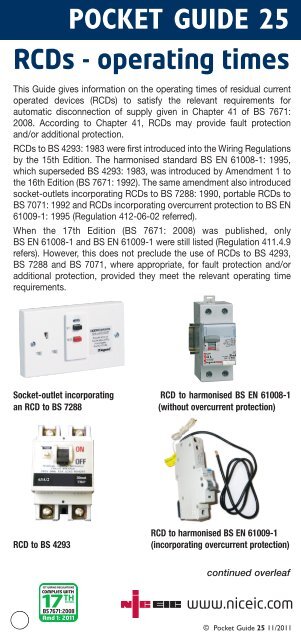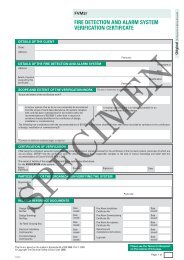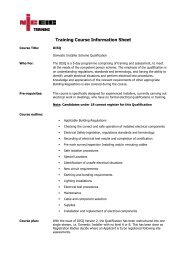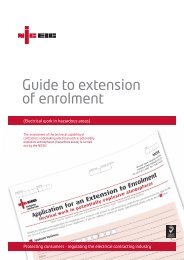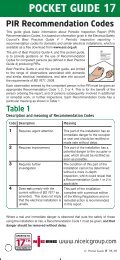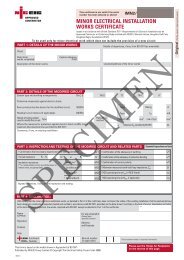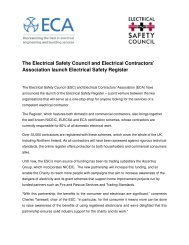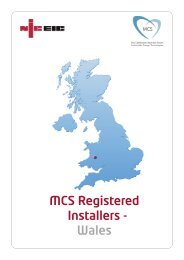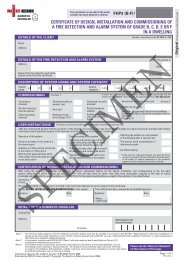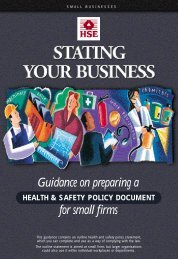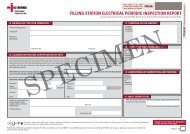RCDs - NICEIC
RCDs - NICEIC
RCDs - NICEIC
Create successful ePaper yourself
Turn your PDF publications into a flip-book with our unique Google optimized e-Paper software.
POCKET GUIDE 25<strong>RCDs</strong> - operating timesThis Guide gives information on the operating times of residual currentoperated devices (<strong>RCDs</strong>) to satisfy the relevant requirements forautomatic disconnection of supply given in Chapter 41 of BS 7671:2008. According to Chapter 41, <strong>RCDs</strong> may provide fault protectionand/or additional protection.<strong>RCDs</strong> to BS 4293: 1983 were first introduced into the Wiring Regulationsby the 15th Edition. The harmonised standard BS EN 61008-1: 1995,which superseded BS 4293: 1983, was introduced by Amendment 1 tothe 16th Edition (BS 7671: 1992). The same amendment also introducedsocket-outlets incorporating <strong>RCDs</strong> to BS 7288: 1990, portable <strong>RCDs</strong> toBS 7071: 1992 and <strong>RCDs</strong> incorporating overcurrent protection to BS EN61009-1: 1995 (Regulation 412-06-02 referred).When the 17th Edition (BS 7671: 2008) was published, onlyBS EN 61008-1 and BS EN 61009-1 were still listed (Regulation 411.4.9refers). However, this does not preclude the use of <strong>RCDs</strong> to BS 4293,BS 7288 and BS 7071, where appropriate, for fault protection and/oradditional protection, provided they meet the relevant operating timerequirements.Socket-outlet incorporating RCD to harmonised BS EN 61008-1an RCD to BS 7288(without overcurrent protection)RCD to BS 4293RCD to harmonised BS EN 61009-1(incorporating overcurrent protection)continued overleafAmd 1: 2011www.niceic.com© Pocket Guide 25 11/2011
POCKET GUIDE 25<strong>RCDs</strong> - operating timesTo verify that the operation time requirements of BS 7671 are met, <strong>RCDs</strong>are required to be visually inspected, and tested for effectiveness with asuitable instrument to BS EN 61557-6 (Regulations 612.8.1 and 612.10refer).The measured operating times of <strong>RCDs</strong> should be compared with theappropriate value(s) given in the table below, which relate to type-testscarried out by RCD manufacturers under specified conditions.In addition, <strong>RCDs</strong> employed for additional protection (which are requiredby Regulation 415.1.1 of BS 7671 to have a rated residual operatingcurrent (I Dn ) not exceeding 30 mA) should be tested at a residual currentof 5 I Dn to verify operation within 40 ms.Measured operating times should be documented in accordance withChapter 63 (Certification and Reporting) of BS 7671.<strong>RCDs</strong> – conditions required for a satisfactory test resultRCD type Instrument test Satisfactory resultcurrent setting<strong>RCDs</strong> to BS 4293, 100% of rated RCD should operate inand RCD protected residual operating less than 200 msaccessories to BS 7288 current (I Dn )<strong>RCDs</strong> to BS 4293 100% of rated RCD should operateincorporating residual operating between 200 ms +a time delay current (I Dn ) 50% of the time delayand 200 ms + 100% ofthe time delay<strong>RCDs</strong> to BS EN 61008, 100% of rated RCD should operate inand BS EN 61009 residual operating less than 300 mscurrent (I Dn )<strong>RCDs</strong> to BS EN 61008, 100% of rated RCD should operateand BS EN 61009 residual operating within the time range‘Type S’ incorporating current (I Dn ) 130 ms to 500 ms*a time delay* If the device does not operate within the disconnection time required byBS 7671, it will be necessary to re-test the device using a current of at least2 I Dn to verify operation (see Table 3A of BS 7671).Following testing for effectiveness by instrument, <strong>RCDs</strong> are requiredto be operated by their integral test facility to verify functionality(Regulation 612.13.1 refers).Note: fuller information on testing <strong>RCDs</strong> is given in the <strong>NICEIC</strong> Inspection,Testing and Certification book.www.niceic.comFor further copies of this guidetelephone 0870 0130382 or e-mail customerservice@niceic.com© Pocket Guide 25 11/2011


